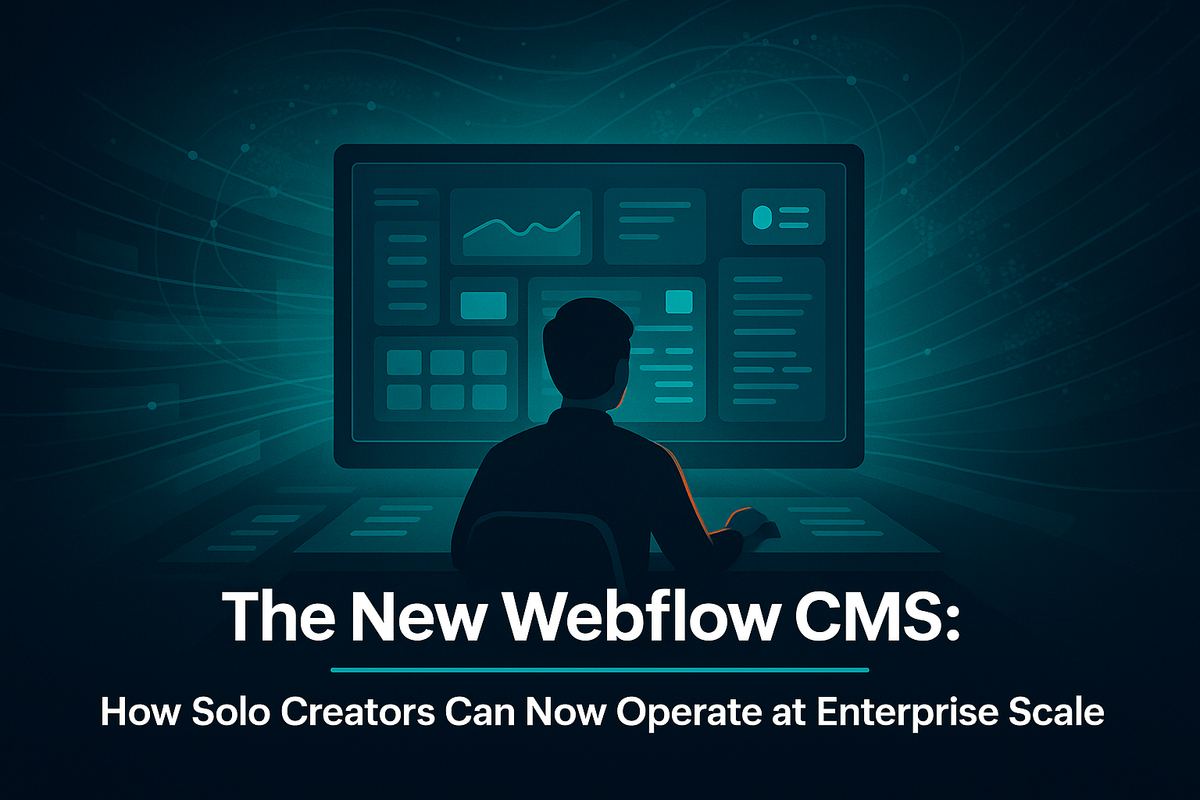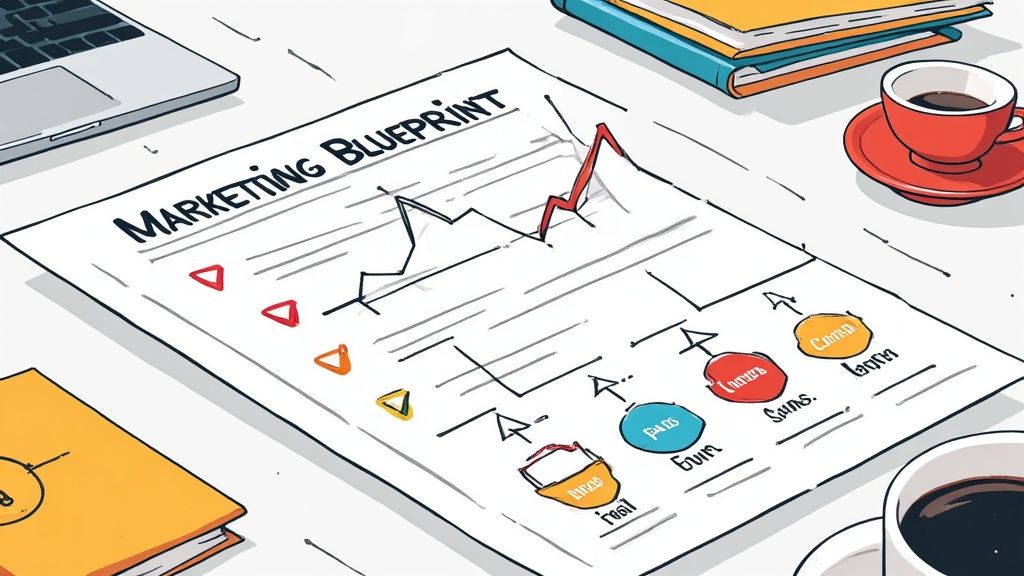The New Webflow CMS: How Solo Creators Can Now Operate at Enterprise Scale
How one person can now manage millions of CMS items, multi-language content, and enterprise-grade workflows, all inside Webflow.

When Webflow first introduced its CMS back in 2015, it was a big deal: a visual way to manage dynamic content without writing code. But for years, it had ceilings - limited collection sizes, a separate editor, and technical constraints that made it hard for solo creators or small agencies to build truly large-scale sites.
That changed in 2025.
Webflow rebuilt its CMS from the ground up, launching what it calls the “Next-Gen Webflow CMS” - a re-architected, AI-ready content engine that can handle millions of items, power multilingual sites, and connect to any external platform through APIs.
This update isn’t just a technical improvement. It quietly transforms what one person or a small team can do.
Here’s how.
What makes the “next-gen” Webflow CMS different in 2025?
In September 2025, Webflow announced the most significant update to its CMS since it launched: a complete backend re-architecture designed for an “AI-first world.”
That phrase might sound buzzwordy, but the changes behind it are real.
The new CMS runs on Webflow Cloud, the platform’s upgraded hosting layer built on Cloudflare’s global edge network. It’s faster, more stable, and, crucially - infinitely more scalable.
Under the hood, Webflow replaced the old CMS storage and publishing engine with one that can handle massive data structures and millions of items. You can now think of Webflow’s CMS less like a spreadsheet and more like a relational database that lives inside your design tool.
Key upgrades introduced in 2025:
- Scale without limits: Enterprise plans can now host over 1,000,000 CMS items, and even individual collections can hold up to 1 million entries.
- More complex structures: Up to 40 Collection Lists per page and multi-level nesting up to three layers deep, allowing dynamic “lists within lists” (like categories → subcategories → related posts).
- Speed and stability: Publishing, backups, and restores are faster and more reliable, even on sites with tens of thousands of pages.
- Headless delivery built in: Webflow’s Content Delivery API, once an Enterprise-only feature, is rolling out to all users - so even solo creators can feed CMS content to apps, external sites, or AI tools.
- Future-proof architecture: Webflow explicitly stated that this rebuild lays the foundation for AI-assisted workflows and smarter automation across the platform.
In short: Webflow didn’t just raise limits - it changed the class of projects that are possible.
How does this scale benefit solo creators and small teams?
For most Unkoa readers, solo consultants, micro-agencies, indie SaaS founders, the difference isn’t just about scale. It’s about independence.
Before 2025, hitting Webflow’s CMS ceilings meant compromise: either pay for Enterprise (and deal with sales calls), or start splitting your content across multiple sites and databases. That’s no longer necessary.
1. Big-site potential without enterprise headaches
You can now build massive content libraries, blogs with 50,000 posts, directories with 100,000 listings, product catalogs with endless variations, all from the same Webflow dashboard. No developers, no migrations, no API workarounds.
Publishing thousands of new pages or localizations at once is no longer risky. The CMS can handle it natively.
2. Affordable “pay-as-you-grow” pricing
Webflow’s new Growth plan bridges the gap between the old CMS and Enterprise tiers. It supports up to 20,000 CMS items and more collections without locking you into a custom contract.
For solo creators, this means you can start at $20–30 per month and scale gradually — adding capacity only as your content or audience grows.
3. Less reliance on third-party tools
Many solo Webflow users previously depended on external tools for localization, commenting, or automation. The new CMS brings those features in-house.
You can now manage multi-language content, gather feedback directly on the page, and even automate publishing — all inside Webflow.
4. Enterprise-grade infrastructure for everyone
Webflow Cloud runs on the same global CDN and security backbone used by top SaaS companies. Sites now benefit from 99.99% uptime, HTTP/3 delivery, and real-time scaling — even on lower-tier plans.
For a freelancer or small agency, that means your portfolio or client projects now live on the same infrastructure as enterprise websites.
No plugins. No server management. No crashes when something goes viral.
Can Webflow CMS now power multilingual sites natively?
Yes — and it’s one of the most transformative updates for content creators.
In late 2024, Webflow launched Localization, a built-in way to manage multi-language sites directly in the Designer. By 2025, it became deeply integrated with the CMS.
You can now create multiple locales (like English, Spanish, and French), and Webflow automatically duplicates your site structure — including CMS Collections — for each locale.
Here’s how it works:
- Each locale gets its own set of CMS items, which can inherit or override content from the primary language.
- You can edit or translate directly in the Designer or in Edit Mode, switching between locales in one click.
- Machine translation is available to auto-translate CMS fields in bulk, then manually refine them.
- Every localized page automatically generates hreflang tags and sitemap entries for proper SEO indexing.
- Localized URLs follow best practice (
/es/,/fr/, etc.), and Advanced plans support translating slugs too.
Even small creators can now serve multilingual audiences without juggling duplicate sites or paying for external translation tools.
Localization is offered as an add-on (starting around $9 per locale per month) and is fully CMS-aware — meaning your content structure remains unified across languages.
For example: one “Blog Posts” collection, many language variations, all linked and managed from one dashboard.
For freelancers with international clients, this removes a huge technical barrier.
What’s changed about editing, collaboration, and workflow?
Webflow’s CMS overhaul wasn’t just about scale — it also changed how people collaborate on content.
Edit Mode replaces the old Editor
Instead of sending clients to a simplified Editor interface, Webflow now lets collaborators edit content directly inside the Designer.
They can switch to Edit Mode, where they can:
- Edit any text or image inline
- Update CMS items from the canvas or the Collections panel
- Upload media, edit alt text, and publish drafts
- See live design context without being able to change layout or styling
It’s a small UX change that saves hours of friction.
Clients no longer ask, “Where is this text in the Editor?” — they just click it, edit it, and see the result.
Auto-save, draft mode, and safer publishing
In mid-2025, Webflow introduced auto-save for CMS edits.
Now, as you type, changes are saved automatically — no more clicking “Save” or losing edits if you close a tab.
If you’re editing a published item, Webflow keeps it as a draft revision (“Changes in Draft”) until you hit Publish.
This lets teams edit freely without worrying about half-finished updates going live.
On-canvas commenting and client feedback
One of the most underrated upgrades: on-canvas commenting for CMS items.
You can now comment directly on dynamic content (like a blog post pulled from the CMS) inside the Designer or on staging.
Clients can tag feedback on specific elements, and comments can be filtered by CMS item — for example, seeing all feedback related to “Post #53” instead of every post using the same template.
Comment-only sharing links
In late 2025, Webflow began rolling out comment-only links, letting anyone (even without a Webflow account) leave feedback on a staging link.
This turns Webflow into a real collaborative environment — no more screenshot markups or endless Google Doc comments.
Real-time multi-user editing
Currently in beta, Webflow’s real-time collaboration allows multiple users to edit the same project simultaneously — similar to Google Docs or Figma.
For small teams, this means no more “locked site” messages. Designers and content editors can finally work together live.
Taken together, these updates make Webflow a legitimate content operations platform — not just a design tool.
For solo creators or tiny agencies, it feels like having a content management system, feedback hub, and publishing pipeline all in one place.
Can creators use Webflow as a headless CMS now?
Yes. This is one of the biggest quiet revolutions behind the next-gen CMS.
The Content Delivery API is now for everyone
Previously locked behind Enterprise plans, the Content Delivery API is now rolling out to all users.
It provides fast, read-only access to published CMS content, cached at the edge of Webflow’s CDN.
That means you can now use Webflow as the backend for:
- A mobile app pulling data from your CMS
- A custom front-end built in Next.js, React, or Svelte
- External platforms like chatbots, newsletters, or internal dashboards
Requests hit a global CDN cache (api-cdn.webflow.com), so responses are lightning-fast and scale effortlessly.
For solo developers or indie SaaS builders, this opens new possibilities: you can design and manage content visually in Webflow, then deploy it anywhere.
DevLink, Webflow Cloud, and the composable stack
Webflow’s DevLink lets you import Webflow-designed components into React apps, bridging design and code. Combined with Webflow Cloud — which supports full-stack frameworks like Next.js — you can now host both your marketing site and app on Webflow, sharing the same CMS and design system.
In short: Webflow is quietly turning into a composable platform.
Design, content, and development no longer live in separate silos — they can all sync through one CMS.
Is the new CMS faster, more reliable, and SEO-ready?
Yes. Performance is a core part of the rebuild — and it shows.
Faster publishing and near-instant updates
The new CMS significantly reduces publish times, even for huge sites.
Webflow re-engineered publishing, backups, and restore processes to operate at scale — so pushing thousands of changes is now seamless.
For users, this means less waiting and fewer publishing errors.
For visitors, it means a faster, more responsive website served from Cloudflare’s 125+ global edge locations with built-in caching.
Surge protection and uptime
Every site on Webflow Cloud benefits from automatic surge protection.
Traffic spikes — like a viral post — no longer threaten your uptime or performance.
The system dynamically scales bandwidth with no overage fees, ensuring smooth delivery under load.
SEO improvements and AI-assisted optimization
Webflow’s CMS has always produced clean, semantic HTML, but the 2025 updates added new SEO depth:
- Localized SEO: Each language version gets its own sitemap, hreflang tags, and custom meta data.
- AI meta generation: Webflow’s AI can generate titles, meta descriptions, and structured data in bulk for large CMS collections.
- Responsive assets and image reuse: You can now reuse CMS images as Open Graph images and optimize them automatically for speed.
- AI analytics: Webflow’s built-in Analyze and Optimize tools track not just traffic but AI-generated visits (like ChatGPT or Bing Copilot scraping your content).
Combined, these features keep sites fast and SEO-friendly — even with huge content libraries or multiple languages.
What should current Webflow users do to prepare?
Most users won’t need to lift a finger.
Webflow’s migration to the new CMS is handled automatically behind the scenes.
Still, a few steps can help you get the most from it:
1. Check your plan
If you’re on an old CMS or Business plan, consider upgrading to the new Growth tier for higher collection and item limits.
Conversely, if you were on Enterprise just for capacity, you might now be able to scale down.
2. Review your site structure
Revisit any content workarounds you used to overcome past limits — like splitting content into multiple collections or using custom embeds.
You can now consolidate and simplify.
3. Test integrations
If you use custom code or automations (Zapier, n8n, Make), update endpoints to the new api-cdn.webflow.com API for better speed and caching.
4. Introduce your team to Edit Mode
Train collaborators to use the new Edit Mode and commenting system. It’s much faster than the old Editor flow and saves you review cycles.
5. Plan for localization early
If you plan to add new languages, enable Localization and experiment on a staging version. It integrates tightly with CMS collections, so starting early keeps things organized.
6. Use the power responsibly
The new CMS gives you freedom — but remember: a million items on one page is still a bad idea.
Use pagination, filters, and search. The power’s there; the discipline is up to you.
The bigger story: a platform that finally scales with you
For years, Webflow’s CMS was a powerful but limited tool. Great for small projects, but tricky once you outgrew it.
Now, in 2025, it’s a full-fledged content platform — capable of handling enterprise workloads while remaining accessible to solo creators.
You can manage global content, collaborate in real time, deliver data to multiple platforms, and still design visually.
For Unkoa’s audience — founders, consultants, and digital builders — that means fewer compromises.
You can operate like an enterprise without acting like one.
The line between “creator” and “company” just got blurrier.
And for anyone building online, that’s a very good thing.
Affiliate disclosure: Some links may be affiliate links.





